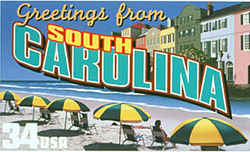
South Carolina Symbols
South Carolina State Names (Etymology of Names)
South Carolina Name Origin and State Nicknames
South Carolina is a state in the Southeastern United States. South Carolina is bordered to the north by North Carolina; to the south and west by Georgia, located across the Savannah River; and to the east by the Atlantic Ocean. South Carolina is the 40th most extensive and the 24th most populous of the 50 United States.
South Carolina was named to honor King Charles I (Carolus is Latin for Charles).
South Carolina Nicknames
- Palmetto State
- Rice State
- Iodine State
- Keystone of the South Atlantic Seaboard
- Swamp State
- Sand-lapper State.
Origin of South Carolina State Name
South Carolina was named in honor of Charles I of England.
North and South Carolina were one colony until 1729. Carolina was named to honor Charles IX of France and then Charles I and Charles II of England. Carolina is rooted in Latin and comes from the word Caroliinus. This word is derived from the name Carolus, translated as "Charles."
South Carolina Nicknames
Palmetto State
For the tree and a Revolutionary War battle. The palmetto palm (a variety of fan palm) has been associated with South Carolina since colonial days, and the first appearance of Palmetto State (the nickname used in modern times) appears to have been around 1843.
Iodine State
For high iodine content in plants. In the late 1920s, the South Carolina Natural Resources Commission began a public relations campaign to advertise the high iodine levels found in fruits and vegetables grown in the state. Even South Carolina milk was promoted as containing extraordinarily high levels of iodine. Promotional tracts sought to expand the national market for South Carolina produce by warning Midwestern and west coast residents of the consequences of iodine deficiency in the young, including enlarged thyroids, mental and physical birth defects, and even sterility. The campaign placed the motto "Iodine" on South Carolina automobile license plates in 1930, then expanded the phrase in subsequent years to "The Iodine State" and "The Iodine Products State." Columbia radio station WIS took its call letters to promote the "Wonderful Iodine State." Even low country moon shiners around Hell Hole Swamp jumped on the iodine bandwagon, advertising their brand of liquid corn with the slogan: "Not a Goiter in a Gallon."
Despite the promotional gimmicks, South Carolina agriculture saw little benefit from the iodine campaign. With the advent of iodized salt in the 1940s, Americans had a convenient dietary supplement and demand for foods high in iodine content declined.
Rice State
The production of rice in South Carolina led to this nickname for the state.
Swamp State
South Carolina is known for the swamps and marshy areas where rice is grown
Sand-lapper State
This derogatory name probably referred to the poorer residents of the state living on the sandy ridges where scrubby pine forests grew. It was said, in jest, that they lapped up sand to stay alive.
Keystone of the South Atlantic Seaboard
South Carolina's wedge shape is the basis for the "Keystone of the South Atlantic Seaboard."
Seaboard State
Short version of "Keystone of the South Atlantic Seaboard." and lies along the Eastern Seaboard. Olmsted published a book called A Journey in the Seaboard Slave States.
South Carolina Slogans
- Smiling Faces. Beautiful Places
- Nothing Could be Finer: State license plates use the first words of the song
South Carolina Postal Code
- SC
South Carolina Resident's Name
- South Carolinian - Official (recommended by US GPO)

The Etymologies of US State Names





